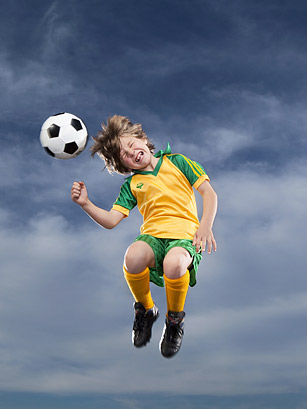
I didn't get a good look at the little boy who injured my daughter in the science museum in Mexico City. He seemed to be about 7, my daughter Elisa was not yet 3, and the two of them were part of a scrum of kids playing on an indoor patio. At precisely the wrong moment, she turned left, he turned right, and they collided. Physics being physics, the smaller mass yielded to the larger one, and my daughter fell down. She landed first on her bottom, then tipped backward and hit her head on the floor.
The sound was one that parents dread: the singular clunk of skull striking cement. I winced, Elisa wailed, and I gathered her up. Soon she stopped crying and went off to play, but even as she did, a dangerous process had begun to unfold inside her skull.
When Elisa's head hit the floor, the deceleration was sudden, but — physics again — her brain stayed in motion for an instant, moving through the small intracranial space until it collided with the back of the inside of her skull. Concussive energy radiated through the tissue. As it did, channels in the neurons opened wide, allowing calcium ions to flow into the cells, depressing their ability to metabolize energy. Brain tissue began swelling, but with nowhere to go, it squeezed up against the skull wall. Shearing forces tore axons connecting the cells, damaging their myelin sheathing, which can disrupt nerve signals. All of that was the best-case scenario. The worst case was a brain bleed, which could be fatal without immediate surgery.
Within 20 minutes, Elisa grew withdrawn. An hour later, back in our hotel, she vomited and then began thrashing convulsively. We rushed her to a hospital, where doctors struggled to get a line into one of the tiny veins in her arm, shouting at her to stay awake.
"Open your eyes!" I shouted at her in English. "Abre tus ojitos!" my wife echoed. Elisa understood both languages; she answered in neither.
Finally, the doctors got her into a CT scanner, then administered an EEG. There was no bleeding, but there was swelling. Elisa spent three days in the hospital taking antiseizure and antiswelling medication and finally was released. On the flight home, she was a terror — but only in the way a toddler is supposed to be.
For us, that was a first-time — and, we dearly hoped, last-time — experience, but we're hardly alone in having gone through it. In the U.S., concussions are an alarmingly commonplace injury, particularly among kids and most particularly among active, athletic ones. Up to 3.8 million Americans are getting concussed per year, according to the Centers for Disease Control and Prevention, and even that big a figure is a moving target. In 2005, the number of children who visited emergency rooms for treatment of concussions was more than twice what it had been in 1997, according to a new study in the journal Pediatrics. High school football players alone sustain 100,000 full-blown, diagnosed concussions per year. Flying under the radar are injuries mild enough to get passed off by coaches as a mere ding or ignored by players anxious to get back on the field.
According to a study by neuroscientist Kevin Guskiewicz of the University of North Carolina, the average college football player sustains a breathtaking 950 to 1,100 subconcussive blows per season — hits that are enough to do cumulative damage to young brain tissue but not enough to cause immediate symptoms. "There's what we call a dose response," Guskiewicz says. "After a certain number of hits, the damage starts to show."
But while football is responsible for more than half the concussions kids suffer playing team sports, there's a lot more blame to go around. The success of Title IX, which forbids gender discrimination in scholastic athletics, has led to a 900% increase in girls' sports teams since the law's passage in 1972. But guaranteeing girls equal access to sports also guarantees them equal access to injuries. Girls' soccer accounts for nearly 12% of total team-sports concussions, compared with just 6.6% for boys' soccer. Girls' basketball causes 7%. Even volleyball weighs in at 1.1%.
What's more, a third of all concussions among kids are caused by nonteam activities such as ice skating, bicycling and playground recreation. Gaining fast too are newer head-cracking activities like snowboarding and extreme skateboarding. Kids may be the first group to fall in love with such sports, but they're the last group — neurologically speaking — that should engage in them.
"The immature brain is still developing," says Julian Bailes, a neurologist at West Virginia University and the medical director for the Pop Warner Youth Football program. "That makes it more susceptible to damage and more likely to suffer repetitive injury." How this shapes overall development is unknown. A child's brain is like a ship en route to somewhere: a concussion can blow it off course.